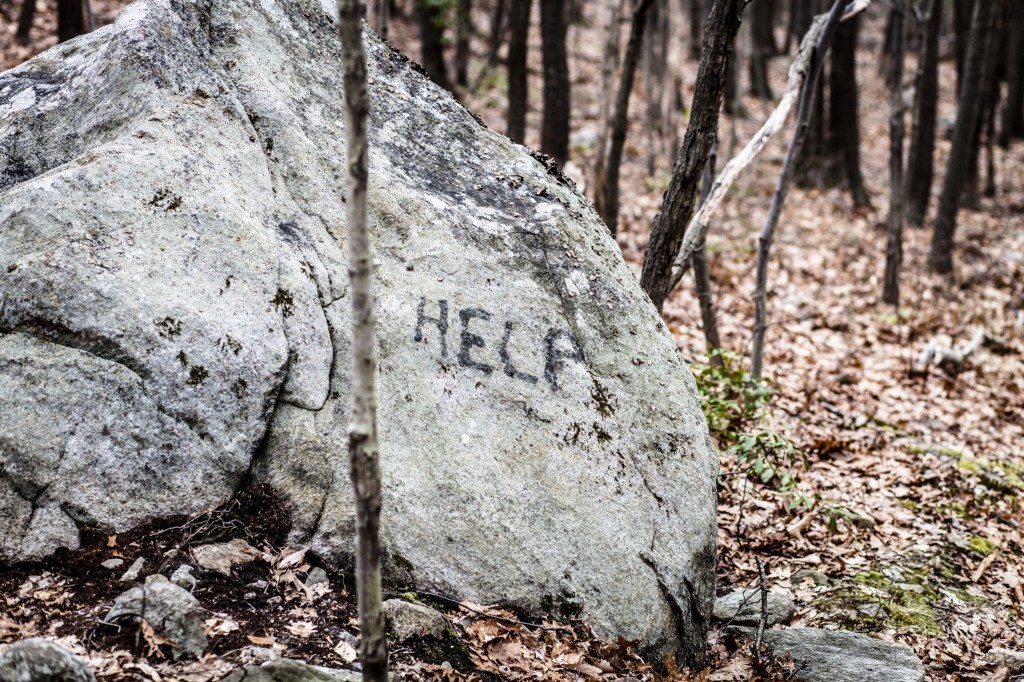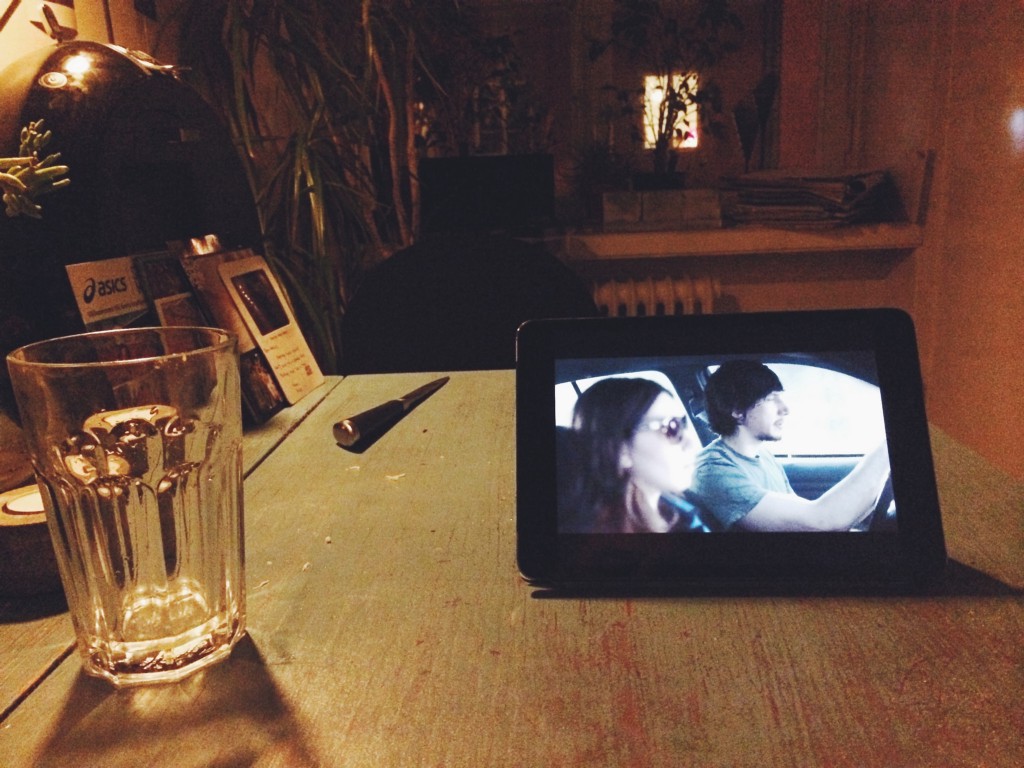Twelve Weeks Later
A reflection in verse

I don’t know why your goals seem so elusive to achieve
I can’t say when your dreams became too earnest to believe
I’m not sure why you always pick these fights that you can’t win
I wish I had some tips to help you feel like you fit in
I’m sorry I can’t tell you why your heart’s so uninspired
I haven’t got an answer that explains how you’re so tired
But as for why you wake each day with no hope of reprieve
Well, that one’s pretty easy: ’Cause this fucking guy won’t leave
The Boy
The Adventures of Liana Finck

Liana Finck’s work appears in The New Yorker, in Catapult, and on Instagram.
Wayward, "Orissa" (CSGRV remix)
What was that about?

I never managed to figure this week out, but at least we’re coming to the end of it, which, these days, is an accomplishment in and of itself. Will there even be a full week next week to get through? Nobody knows! (Although if there is the one thing we can be certain of is that it will last forever.) Anyway, it’s Friday and here’s some music. Enjoy.
New York City, April 12, 2017

★★★★ The air had grown even heavier overnight. Jackhammer noise carried in the window. Hazy peach tones softened the distance beyond the flat, glossy river. Daffodils were out in newly installed clusters with fresh potting soil around them. The clouds closed over, well after the first forecast time for showers had come and gone. Thunder sounded and rain came straight down without further dramatics. People kept walking in it. There was not enough to sluice away the dirt, just to make dirty puddles. The atmosphere behind it was clean and refreshed, though it picked up little local clouds of odor from things left wet and reeking. At last it was safe again to wash pants and hang them up to dry. Couples out walking or running errands in the still-warm night weren’t preening but were visibly glad to be with each other.
Show Watched
On binge-watching “Girls”

Binge-watching has always struck me as the more objective way to watch a show. No distractions, no recaps, no waiting a week and hearing people’s stupid theories about which person in Monterey gets murdered and who’s really biting Amabella. No podcasts, no in-depth “after the show” segments. No live-tweeting or spoiler alerts or fan fiction. Just more and more and on and on and on like a good book you can’t put down.
Sometimes I think the biggest problem with Lena Dunham’s HBO series “Girls” was its audience. The “conversation.” Me. You. Everyone Miranda July knows. We were the echo chamber of a generation, and for five years all we’ve been able to talk about is how this show exists. Can you believe it? “Girls” clearly struck a nerve that rattled and buzzed like a funny bone and that resonance has weirdly been its own biggest distraction.
So I’m glad that Awl pal Jia Tolentino has done a very clever thing, which is to consume “Girls” all in one binge, from start to finish in order to give us what reads as a fairer analysis of a television show on its own merits instead of what it actually represents. I only recently got back into watching the show after abandoning it for two and a half or three seasons because I was told Matthew Rhys would disdainfully drawl out the words “The Awl” in that “older-person-negs-a-blog” kind of tone. And you know what, fuck me if it wasn’t a very good piece of television, if an uncomfortable one to watch.
I also don’t think “Girls” demands identification as much as satirizes it. The main characters are never more ridiculous than when they are explaining the way they see themselves — in one of Marnie’s funniest moments, at her infelicitous wedding, she described her aesthetic as “Ralph Lauren meets Joni Mitchell,” with a “nod to my cultural heritage, which is white Christian woman.” The fruitlessness of endlessly fine-tuning your self-image — of frantically trying to echolocate your personhood against someone else’s story, real or fictional — is baked into every episode of the show. This is particularly clear in the scant number of episodes, just a dozen or so over six seasons, in which Hannah, Marnie, Jessa, and Shoshanna have appeared as an ensemble. In these episodes, the characters’ interdependent narcissism generally becomes unwieldy: the four of them go to the North Fork with competing ideas of a good weekend, and their trivial preferences become statements of purpose — ammunition for a fight about who they are.
Truth be told, the thing we hated most about “Girls” is how it knew exactly where our buttons are. Read the whole thing here.
On Finally Watching “Girls,” a Different and Better Show Than I’d Been Led to Imagine
The Case Of The Missing Mendelssohn

Has anyone else listened to the new Harry Styles song on repeat for hours on end and then kind of just transitioned into listening to the entire One Direction back catalog, reminiscing on their early 20s and in turn found it almost impossible to focus on classical music without thinking about aging? Cool, me either.
Last week, I brought you a man named Felix Mendelssohn, a Romantic German (to which I must say a big whole-hearted “same” about myself), and this week, I want to bring you the other side of the Mendelssohn coin which is his older sister, Fanny Mendelssohn. It’s possible you know of Fanny, not necessarily from her music, but because she’s a relatively timely composer of late. In only March of this year, it was discovered that her Easter Sonata, once credited to her brother, was actually hers, and it was played live under her name for the very first time this year. Very cool! Congrats, for once in the history of time, to a woman for getting the recognition usually given to a man for an accomplishment.
A Mendelssohn masterpiece was really his sister’s. After 188 years, it premiered under her name.
There’s a big reason as to why Fanny Mendelssohn’s work was credited to her brother, and that’s because in the past, it was illegal for women to do literally anything but get married and have children. But Fanny was a prodigy (I feel both confident and fine calling her by her first name; it is, after all, nearly my own). At the time of her death in 1847 at the age of 41, she had composed 500 pieces. That’s insane.
It’s tough to find a recording of said Easter Sonata so instead, I’ll bring you her Sonata In C Minor written for piano. Certainly one of you is thinking, “Oh, you just loooove to write about piano music, don’t you?” And the answer is yes. And this sonata in particular is the first time I’ve written about a solo piece in particular. It’s just piano, folks. No ramblings about cello or timpani or any other instruments.
It opens with an Allegro moderato e con espresione, or: “moderately quickly and with expression.” I always love notes like that in the title of a movement of a piece. “And with expression,” as if to say, “don’t make this boring.” But that would be nearly impossible with a piece this, well, expressive! This first movement sort of tilts you into itself. It’s slow to start, a little repetitive, but by the 41-second mark, it’s really started to pick up with speed and deliberate beauty. And then! By the 1:30 mark is where you really and fully get the grasp of the power behind Fanny’s composition. Composed in 1824, this would mean that Fanny was 19 years old, the hottest age any one person can be in their whole life, for what it’s worth. Like I said, a prodigy.
The Andante con moto is a step backwards from its first movement. To be fair and honest, I feel her youth showing through in this piece. It’s like trying to write sadness when you don’t know it; in college I wrote a short story about a break-up having literally never gone through one and my professor was like, “this is a big lie.” I wouldn’t be so harsh about Fanny’s piece, not in the slightest, and I don’t even know if it’s fully meant to be sad. But it’s slow without the slowness, heavy without the weight. No doubt it still sounds good. It’s listenable, but I don’t know if there’s anything really being said.
That all said: the third movement, the Presto, is a powerhouse of a piece of music. It races. It jolts you awake, pulls you out of an artificial despair and into this dark and twisty vision of a finale. There’s actual conflict here, and maybe this is the kind of conflict Fanny could really grasp at the age of 19. “I love drama,” that kind of shit. And it’s funny! You almost want to interrupt her, give it a “wait a second,” but that would be unfair to her. There’s such skill in this piece (played so adeptly by Heather Schmidt in this recording). I love the part around the 40-second mark as the treble clef dances around while the chords in the bass clef slowly work their way up in this dramatic, almost foreboding way. The last section of it, kicking into gear around the 2:20 mark, is just pure fun. It’s so playful and good, which makes me want to tear my hair out that Fanny had to do things like publish under her brother’s name. The past was so bad to women, as is the present, and maybe the future. Who knows! But I listen to this and feel some sense of catharsis knowing her work can reach women who will be both comforted and riled by it today.
Fran Hoepfner is a writer from Chicago. You can find a corresponding playlist for all of the pieces discussed in this column here.
A Poem by Matthew Cooperman
Occupational Justice
A sense of urgency in space for arms
Imagine reaching for apples
What is myth to a body missing
The hunger for the apple every day
Someone gets up and stumbles someone
Gets up and stumbles upon an idea
Of safety for the general populace it’s wise
To speak of stairs and reasons and meters
And laws that dictate suffering for a time
Shall be released in a new gravity
As I am lost in the pain of my hand writing
Whole stations of kindness in the cafeteria
To imagine “I am Julia you are Stan”
Our roving together to gather the savor
Daily accidents we learn again
The price for all whose body’s missing
A voice to speak its justice just this once
Matthew Cooperman is the author of, most recently, Spool, winner of the New Measure Prize (Free Verse Editions/Parlor Press, 2016), as well as the text + image collaboration Imago for the Fallen World, with Marius Lehene (Jaded Ibis Press, 2013). He is co-poetry editor of Colorado Review and teaches at Colorado State University.
The Poetry Section is edited by Mark Bibbins.
Eat Shit And Live
A pretty good advertisement for not doing science at home.

Today’s New York Times video of the day is “Gut Hack,” a short film that’s part of their Op-Docs series. This one’s about Josiah Zayner, a former NASA scientist and a man attempting to giving himself a full microbiome transplant. Mainly the thing here is he’s doing a fecal transplant, and that’s the gross and hard to (sorry) stomach part, but I did find it interesting that he aimed to get transplant donor bacteria to his skin and membranes (nose, mouth) as well as his gut. It’s sort of like the bacterial equivalent of the scene in Gattaca where they graft a new fingerprint onto the guy’s hand so he can have someone else’s signature mark. In order to do all this, he had to sanitize himself basically as much as possible by taking a course of antibiotics and scrubbing his skin down in a hotel bathroom as though he’s about to commit a murder and try to leave as little DNA evidence as possible.
Just about a year ago, The Verge reported Zayner’s story in the form of a feature by Arielle Duhaime-Ross, with additional coverage on a podcast conversation between Liz Lopatto and Emily Yoshida. The footage from the Verge’s photoshoot appears to be from the same experimentation period as the short film, so I guess there were not one but two camera crews onsite for this man’s poop transplant? (Oh yeah, by the way, you can definitely see Zayner grinding up a poop solution with a mortar and pestle on his kitchen counter.)
Why we have an Op-Doc about a thing there is already an article and a podcast about I don’t know, but I assume the reason is something like “great minds” and also “the content has to be mined for every last drop.” The Verge folks provide what is, in my opinion, some pretty necessary caution and perspective to the whole experiment, stressing among other things the fact that, first of all, you can’t really scrub yourself clean of bacteria the way Zayner attempts to do—“Rubbing your skin with tetracycline powder is not going to sterilize it,” Elisabeth Bik, a microbiologist at Stanford University, told Duhaime-Ross. And second, Zayner was pretty lax in his methods. Duhaim-Ross writes:
I couldn’t help but notice Zayner cutting corners. After drying off, he put on a brand-new Hanes white T-shirt to prevent his old microbiome from recolonizing his body, but an old — though freshly laundered — pair of jeans. He sampled his arms, nose, and mouth, but he didn’t bother to take microbial samples from his genitalia, and didn’t plan on applying Michael’s skin bacteria to his penis or testicles. He told me that there just isn’t much scientific value in gathering that information. Over the course of his experiment, Zayner would only take a third of the poop pills that someone undergoing a standard FMT procedure would, stretched over a longer period of time.
Sure, he wasn’t doing good lab science, maybe because he wasn’t in a lab and didn’t “give a shit” (sorry) about his methods so long as he got enough gut bacteria to make his tummy feel better, and any feeling human can relate to that desperation. But an ineffective or unsuccessful transplant isn’t the worst thing that could happen—there are a lot of risks involved with fecal matter transplants (FMTs), like viruses and bacteria one could pick up in the process, especially if you do a colossally idiotic thing like not test the fucking donor’s bacteria for potentially harmful pathogens before you give it a new home in your washed-out gut.
But Zayner was that particular combination of desperate and zealous (as a righteous biohacker must be), and with some good reason:
Because shit is considered a medicine when it’s administered by a doctor, the procedure is strictly regulated by the US government, and is only available to patients with recurrent C. diff.
Tens of millions of people have bowel and gut issues that might be treatable (though perhaps not curable) with fecal transplants. One way of making them easier, argued a group of scientists in a Nature editorial, would be to reclassify human stool as tissue rather than a drug, so it would not be subject to clinical trials. The idea is not to bypass testing and experiments altogether, but to lower the bar for access so that’s getting an FMT is more like a blood or bone marrow transfusion. And the only way to do THAT is to pass an act of Congress! So ahhh, nevermind—pass the TUMS.
The xx, "A Violent Noise" (Four Tet Remix)
Grrr: A Look Back

I don’t know about you, but I was in a bad mood yesterday. Everything pissed me off, and I am someone who wakes up each morning already rubbed the wrong way — which is understandable given that these days there is pretty much nonstop garbage pelted at you from the second you reluctantly open your eyes to the moment you mercifully manage to close them — so it takes a good deal of indignity and affront to make a day appreciably awful for me. But for whatever reason, yesterday was worse than usual. Why? I blame the weather. It’s not like life was appreciably dumber than it was the day before. I mean, except for that Easter explainer, that was pretty fucking gross. But other than that, it was just the normal level of stupidity and insults directed at me as an individual and as a member of the species. Will today be better? Who the fuck knows? I’d like to say it would have to be but I have been wrong about that pretty much any time I’ve predicted it, so I’m going to keep my idiot mouth shut. Was yesterday an endless parade of irritation for you? Bitch about in on social media like everyone else, why don’t you? In the meantime, here’s another great remix from Four Tet. Enjoy.
New York City, April 11, 2017

★★★★ The children went out to the playground and came back again with plenty of morning still left. A palomino police horse clopped down the cross street. On the bottom of Union Square, heat and light were bouncing up off the sidealk to meet the incoming heat and light. The air in the coffee shop was stuffy enough to settle the question of whether to switch to iced. Over on Fifth Avenue, though, a breeze was counterbalancing the sun. Six trees were in leaf. The bakery’s cold-weather vestibule was gone and all the sidewalk tables were out. Door after door hung open. Knees and shoulders were out; delicate fabrics floated. Within a few hours, the breeze had pushed out the heat. A green fog floated where the tree canopy would have to manifest itself before too much longer. Humid air pushed its way into the bedroom at night.
